This is an ANSCO Color Clipper, a rigid bodied scale focus camera that shoots 6cm x 6cm images on 120 format roll film. The Color Clipper was part of ANSCO’s Clipper line which first went into production in the mid 1930s. Like all Clippers that came before it, the Color Clipper had a collapsible front that slid forward on a light tight metal box, instead of folding bellows like on other 6×6 cameras of the day. This not only allowed ANSCO to sell them for cheaper but the metal box was also more rugged and did a better job of keeping out light leaks. The lens was a color coated doublet that maximized sharpness and depth of field, without adding complexity or cost. Like many simple cameras of the 1950s, the ANSCO Color Clipper was an easy to use snapshot camera for the family who needed something to capture special moments on vacation with a minimum amount of fuss.
Film Type: 120 Roll Film (twelve 6cm x 6cm exposures per roll)
Lens: Unknown Focal Length (probably ~75mm) f/11 ANSCO coated 2-elements
Focus: 4 feet to Infinity
Viewfinder: Scale Focus
Shutter: Metal Blade
Speeds: Single Speed ~1/30
Exposure Meter: None
Battery: None
Flash Mount: M and X Sync w/ Anscoflash Type IV
Weight: 551 grams
Manual: https://www.cameramanuals.org/agfa_ansco/ansco_color_clipper.pdf
How these ratings work |
The ANSCO Color Clipper is an attractive and easy to use medium format camera sold for a short time in the late 1950s to families looking to make 6×6 images on color film. Although the camera works fine with black and white film too, the presence of the word “Color” in it’s name and colorful body was intentionally done to capitalize on the rise in popularity of color film at the time of it’s release. There’s nothing remarkable about the camera, but there’s also nothing bad about it too. I enjoyed using it, and got some pretty good images out of it, just like owners likely did 60 years ago! | ||||||
| Images | Handling | Features | Viewfinder | Feel & Beauty | History | Age | |
| 1 | 1 | 1 | 1 | 2 | 1 | 30% | |
| Bonus | none | ||||||
| Final Score | 9.1 | ||||||
History
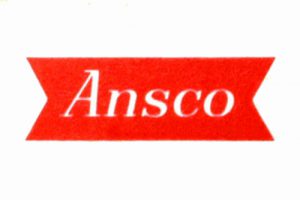 It’s easy when going through all of the expensive and high quality cameras created in the 20th century to forget about the huge number of simpler, more basic cameras that were used in much greater numbers by amateurs all over the world. For every Alpa SLR that was bought, a thousand (or more) Kodak Brownies or ANSCO Cadets were sold with meniscus or doublet lenses, single speed, shutters, and by the end of the 50s, simple forms of auto exposure.
It’s easy when going through all of the expensive and high quality cameras created in the 20th century to forget about the huge number of simpler, more basic cameras that were used in much greater numbers by amateurs all over the world. For every Alpa SLR that was bought, a thousand (or more) Kodak Brownies or ANSCO Cadets were sold with meniscus or doublet lenses, single speed, shutters, and by the end of the 50s, simple forms of auto exposure.
Although many companies from nearly every camera producing country in the world made cheap cameras, the two most successful were Kodak and ANSCO. Perhaps the secret to their success was that at their roots, neither were “camera companies”, rather both were film first companies, and with only the occasional exception, produced cameras as vessels to help promote and sell more film. The thought was, that if you bought a Kodak or an ANSCO camera, you were more likely to buy Kodak or ANSCO film.
In the years that would follow World War II, American culture revolved around young families, largely moving to the suburbs, living in houses with white picket fences featuring a Buick in the driveway, a dog, and a couple kids. These stereotypical American families celebrated birthdays, anniversaries, and holidays, they went on vacations to Yellowstone National Park, the Grand Canyon, and to Disneyland. And when they did all these things, they wanted to take pictures with a camera,
ANSCO and Kodak were both ready and willing to provide these families with the cameras needed to capture all of those memories, but in order to do that, they needed to be cheap, easy to use, and make pictures that were good enough to be printed or shown on a projector.
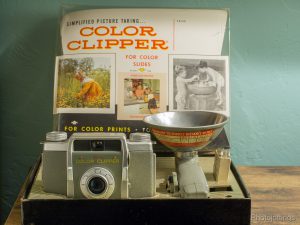
One such camera was the ANSCO Color Clipper from 1958, a camera’s whose name included the word “Color” which was there to capitalize on the increased popularity of color film at the time. The “color” theme continued with a large bright red anodized metal shutter release and a red and yellow logo on a pastel green front plate. The camera used a single speed shutter with the only choices of exposure being a wheel that selected between “B&W” and “Color”, the latter of which allowing the lens to shoot wide open.
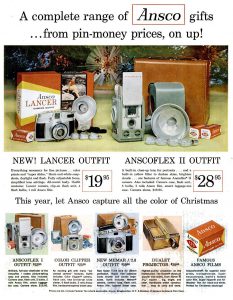
The ad to the right from December 1958 shows a complete Color Clipper outfit for sale with ANSCO’s other holiday offerings with a price of $25.95 which when adjusted for inflation, compares to $233 today. For the price, you got the camera, flash gun, 5 bulbs, 2 rolls of ANSCO film, a universal slide viewer, and a carrying case.
The ANSCO Color Clipper shot twelve 6cm x 6cm exposures on 120 format roll film, and while the company would have much preferred you use ANSCO film, it would have worked on any company’s film, even Kodak, which for customers in the United States was probably a common occurrence. The single 1/30 shutter speed would have been a perfect match for Kodachrome and Anscochrome slide film were both extremely popular at the time.
The Color Clipper, like nearly every camera in it’s class was easy to use and made good images, but was otherwise unremarkable. Cameras like these quickly fell out of favor within a year or two of it’s release with the rise in popularity of “electric eye” cameras that offered automatic exposure to novice photographers.
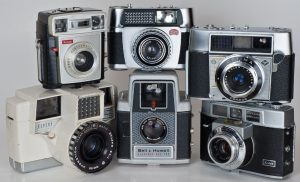
I could never find any official range of dates that the Color Clipper was for sale, but apart from the December 1958 ad above, and another appearance in the 1958 Sears Camera Catalog, it seemed to have disappeared by 1959 suggesting a very short lifespan. My guess is that although ANSCO likely didn’t actively promote the camera after the 1958 holiday season, it could probably still be bought as new old stock at discounted prices for at least a year or two later.
The ANSCO Color Clipper was a short lived model that had features which were very similar to a huge number of competing entry level roll film cameras of the era. Other than a distinct look and easy to use operation, there’s nothing about the camera that really stands out. But that doesn’t mean it’s a bad camera. If you can find one of these cameras in nice condition, especially if it has the original box and accessories, it makes for an excellent addition to your collection.
My Thoughts
This ANSCO Color Clipper is the first of three cameras sent to me by Roger Beal, a long time reader and frequent commenter of this site. Roger contacted me one day and offered to send me three of his favorite cameras that he didn’t feel got a lot of exposure on the web today hoping that I might shoot them and see the same appeal in them as he did.
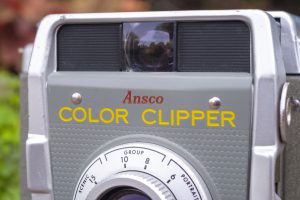
At first glance, the ANSCO Color Clipper caught me eye compared to the other two as it was the most colorful. It would seem that whoever at ANSCO’s design department thought it would be a good idea to give this camera it’s pastel green crinkle paint finish and bright red shutter button and yellow and red accents, was onto something as it certainly jumped out at me.
But bright colors weren’t my only first impressions of the camera. Although a relatively basic camera, at a weight of 551 grams, the Clipper has a bit of heft that you wouldn’t expect from a simple 6×6 camera. Unlike Kodak, who was ANSCO’s primary competition in the 1950s who embraced the widespread use of Bakelite and other plastics, the Color Clipper is all metal. The entire body, the knobs, even the “bellows” are some kind of stamped or die cast metal. If there’s any plastic on this camera, it’s well disguised, giving it a somewhat “premium” feel.

From the top down, the Color Clipper is very symmetrical with two large knobs on the edges. At a quick glance, you might even think this was a 35mm camera with an advance and rewind knob, but only the right knob is used for film advance, not the left. This being a 120 roll film camera, there is no need to rewind the film. Although you can turn the left knob, doing so doesn’t do anything. It can be lifted up though, which is useful when loading new film into the camera as it lifts the spool post out of the way for easier loading.
Between the two knobs is a flat piece of metal with nothing on it. No accessory shoe, no logo, nothing. The shutter release is the large red anodized piece of metal which can only be seen after extending the front of the camera out to the taking position. This clever design eliminates any chance the photographer could accidentally expose film before extending the front of the camera open.
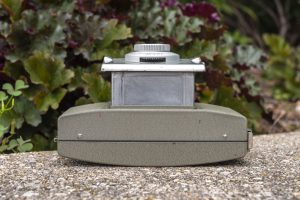
On the bottom of the camera is absolutely nothing. Not a tripod socket, a maker’s mark, or something saying Made in the USA…literally nothing!
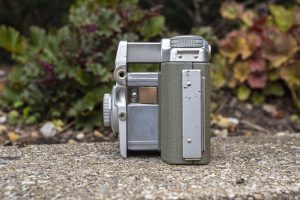
Extending the front of the camera requires gripping the sides of the shutter plate and pulling out with even pressure until you hear it lock into it’s open position. The camera’s left side has both the door release on the side for loading film, but also the connection point on the side of the shutter plate for use of the ANSCO Color Clipper’s flash gun.
When it’s time to close the front, you squeeze in on two chrome clips on either side while pressing the front of the camera back into it’s body.
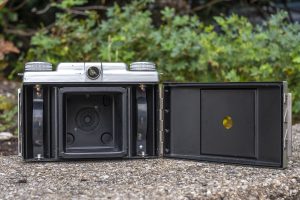
Opening the right hinged film door reveals a rather ordinary roll film compartment. Film transport is from left to right onto whatever take up spool you have available for the right side. The film plane is not flat, having a slight curve to it, which is usually done on lesser cameras to help improve edge sharpness. As is the case of most cameras with curved film planes, the ANSCO Color Clipper does not have a proper film pressure plate, instead relying on the curved inside of the film door to maintain film flatness.
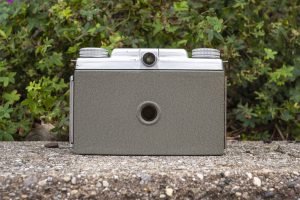
Curiously, the circular window in the back of this camera is yellow, not red. It is possible that the red color has faded over the years, revealing the yellow tint, or perhaps ANSCO film just happened to not be very yellow sensitive. My best guess is that it’s just faded, as when I shot this camera, I taped an square piece I got out of a red gel filter to help protect it. If you happen to have one of these cameras, and your window is yellow, I strongly recommend doing something to protect it, as a yellow filter will allow light leaks, especially when using modern film, which is faster and more light sensitive than the film available when this camera was new.
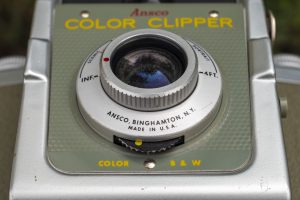
Up front, the lens can be focused by rotating the front grouping from 4 feet to infinity. The lens does not have any click stops, but there are three zone focus ranges for Portrait, Group, and Scene. The shutter has only a single speed that in his test of the Color Clipper, Kurt Munger confirmed was a pretty consistent 1/30. Your only control over exposure is with a wheel on the bottom of the lens with two settings, one for Color and one for B&W. At the Color setting, the lens shoots wide open, and at the B&W setting, a metal plate with a small hole swings in front of the light path. If you shoot the Color Clipper today with 100 speed film, you’ll likely want to leave the setting in the B&W position to compensate for the additional speed over film that was typically available when this camera was new.
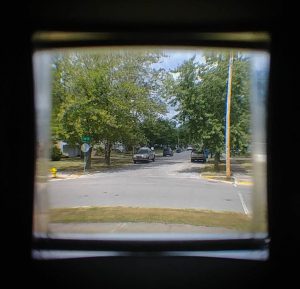
The viewfinder is a straight through clear plastic square window with no exposure information or frame lines visible. Interestingly, the viewfinder goes through the collapsible front of the camera, so you can only see the correct focal length with the lens extended. Since it is impossible to fire the shutter with the lens retracted, there is no chance of mis-framing your image.
On a high level, the ANSCO Color Clipper is just another inexpensive mid 50s 6×6 folding camera that was aimed at the low end of the market and allowed people without a lot of photographic experience to make good, but not great images, and in that regard, it accomplishes it’s task really well.
But to simply label this camera as “just another cheap camera” does not do it justice as there are several nice design elements that suggest it’s creators wanted to make something a little better.
Features like double image prevention, the inability to fire the shutter without extending the camera and a full focusing lens are all nice touches not found on lesser cameras. Plus, from an aesthetic standpoint, the colorful graphics on the body of the camera, along with the attractive red anodized shutter release give the camera a wow factor that perfectly aligns with the increased popularity of color film at the time of it’s release.
The ANSCO Color Clipper is an attractive and fun to use camera that has a few unexpected surprises, but what are the images like?
My Results
My first opportunity came in early spring 2020, just before the world went on COVID-19 lockdown, and although spring colors were not yet in full swing, and wanting to shoot the camera with something that honored the word “Color” in it’s name, all I had in my film drawer was some Kodak Portra 160 that had expired in 2001, so I loaded up the camera and went shooting.
The very first page of the ANSCO Color Clipper’s user manual starts off with, “Your new Ansco Color Clipper camera was designed to enable you to take good pictures with the minimum of effort”, and with that, I really should just end this review here.
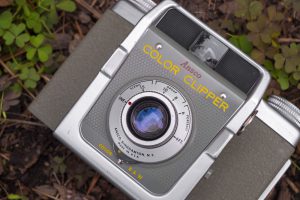
With those aspirations, the ANSCO Color Clipper nails it’s goals perfectly. No one would have bought a camera like this and expected it to hold it’s own to a Zeiss Super Ikonta, or a Rolleiflex. This was a snapshot camera for the family man (or woman) who just wanted something that took good pictures with the minimum amount of effort.
And “good” is exactly how I’d describe what I got from my first roll. Of course the Kodak Portra had aged worse than I had hoped, but strange color cast aside, the images are reasonably sharp across most of the frame. The ANSCO doublet lens does a good of maximizing sharpness and contrast throughout most of the image with out of focus details that aren’t clearly defined and are just sort of there. Vignetting is very strong in the corners of images with the sky in the background, and sharpness noticeably drops off, but not nearly as bad as a box camera with a meniscus lens might.
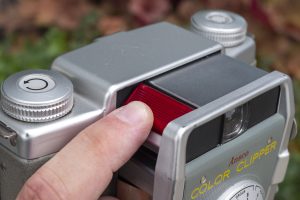
While out shooting, the camera was very easy to use. The clever design of the shutter release that can only be accessed after pulling out the lens eliminates any chance of making an exposure before extending the lens. I also appreciated the double image prevention which would lock the shutter release until after you start to advance the film. Although a pretty basic camera aimed at the non-photographer, the inclusion of a full focus lens is a nice touch as well.
The lens is rated in the camera’s manual at f/11 which I assume is for the Color position. There’s no way to know what the B&W position is, but depth of field is quite good, making focus estimation extremely simple. In fact, I would be willing to bet that you could probably just leave the lens set to the “Group” position and get an entire roll of in-focus images when shooting outdoors.
There’s really not a lot more to say about the ANSCO Color Clipper, but that’s actually a good thing. This was a camera that was supposed to be easy to use and make good pictures, and that’s exactly what it does. With a number of small details like a really nice shutter release, a full focusing lens, a curved film, plane, and double exposure prevention, it gives even the first time photographer a really good chance at making quality images. Make no mistake, this isn’t a Rolleiflex, but it’s not supposed to be either.
Related Posts You Might Enjoy
External Links
http://camera-wiki.org/wiki/Ansco_Color_Clipper
https://photojottings.com/ansco-color-clipper-camera-outfit-review/
http://historiccamera.com/cgi-bin/librarium2/pm.cgi?action=app_display&app=datasheet&app_id=2977&
https://burntembers.com/2017/06/09/testing-the-ansco-color-clipper/


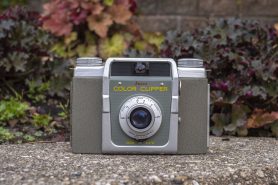
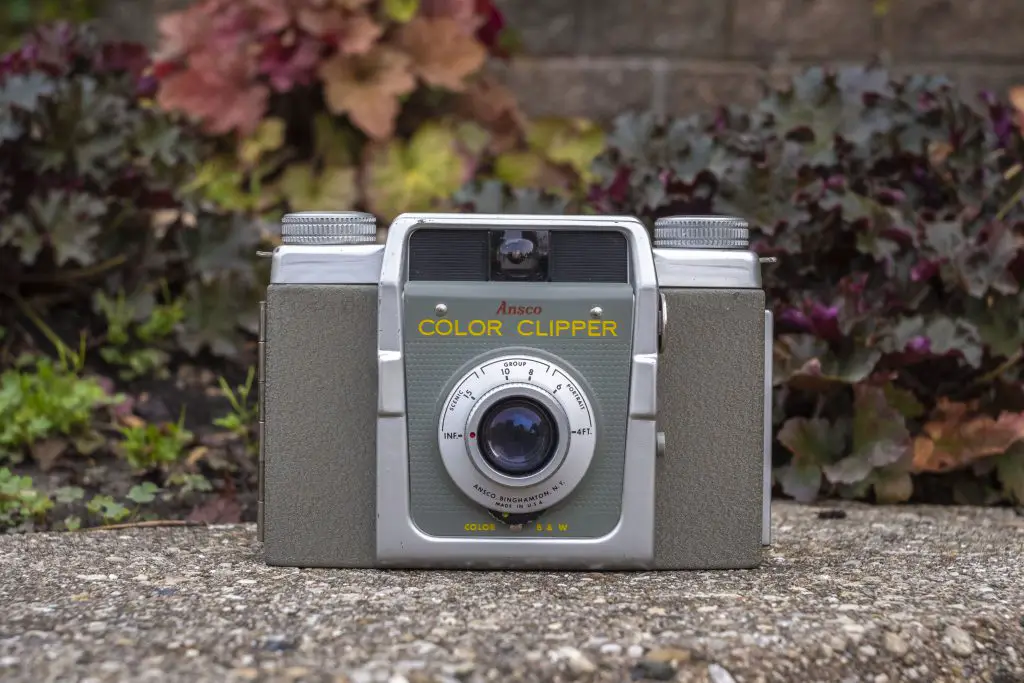











Curved film planes (on simple cameras) rock!
That suburban family was more likely to own a Chevrolet than a Buick. And Disney World didn’t exist yet. (Disneyland, however, opened in 1955.) But I get the idea. Regarding the camera’s aesthetic design, clearly a competent industrial designer(s) was involved. I wonder if the industrial design aspect of various cameras might make for an interesting topic in itself.
You got me on the Disney World/Land mix up, I can never keep track of which one was first! I will hold my ground though on Buick though, as growing up in a family where my dad always had a Buick in the garage (actually he had a Plymouth Satellite at one point), I’m sticking with it! 🙂
Then again, in the movie “A Christmas Story” there is this narration, “”Some men are Baptists, others Catholics. My father was an Oldsmobile man.”. Buick was actually beneath only the Cadillac in the GM market segment pecking order. The Buick target market was “well to do” but perhaps not enough for a Caddy or just didn’t want to show off. Under Buick was Oldsmobile marketed as fairly luxurious but with the most powerful engines. Next down was Pontiac marketed as “sporty” and “youthful”. Chevrolet at the utilitarian bottom, lowest cost, and highest sales. I’m sure there is a certain amount of brand imaging along these lines in cameras, too. In GM’s case, their brands once competed against each other until they focused particular brands on particular markets. I suppose a camera maker similarly doesn’t want to compete with itself and has different camera models carefully marketed to different market segments. I think you touch on that topic now and again in your reviews.
The Color Clipper is indeed one of my favorite basic cameras: The extra effort the designers took to enhance its appearance and make it nearly idiot-proof, put it a notch ahead of many box cameras. I learned respect for 6×6 box cameras early in my photographic career: My dad served in the army in WW2 with a family friend named Bob Purdy. After the war, Purdy founded Associated Photographers in Pittsburgh, and landed ongoing contracts with the major steel companies plus the USW union locals in town. Bob hired me on during a break between high school and college, showed me the basics of using a Nikon F, a Leica IIIf or IIIg, and a Rollei, and sent me on some assignments in the mills – first as an assistant then on my own. He locked me in one of the darkrooms and made certain I mastered b&w printing.
.
But Bob also did something else invaluable to a young cameraman obsessed with the newest and finest gear. I rode along as he took a Brownie Hawkeye, loaded with Verichrome Pan, to the Pittsburgh Airport. Understand this was in 1965, when airport security was limited to keeping people from driving their cars on the runways. Bob stationed himself near the end of the runway and shot planes landing and taking off. His point? That with proper camera technique, even a basic box camera can produce sharp and clear images. He showed me how to position myself so that the sun worked in my favor. He showed me how to pan the camera while shooting, so as to capture a sharp image of the plane with a blurred background. I’ve never forgotten that session, and regularly shoot today with basic cameras that have decent lenses just as an exercise in composition and technique discipline.
Mike, this Ansco hits all the right spots for me. I’ve never seen anything about it until this article. Someone put a lot of thought into not only how it looks (beautiful to me) but also opted for the superior doublet lens instead of relying on a basic meniscus. And then employing scale focus.
And going by your results with slide film, of all things, Ansco got it right. From basic cameras I can be more impressed when they perform as this one has. Even allowing for your full size file access to view them, there is clearly that bit more in the slide that will inevitably be lost in a scan.
And by design or accident, Ansco even future proofed it by dispensing with light leaking bellows!
Glad you liked it. This is the reason Roger loaned me this camera. It hits all the right spots of a simple, yet quality camera that not too many people talk about today. Definitely an under appreciated model.